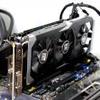A New Island & Technology
Crossfire Connectors & Bridges Are History
Starting with the Radeon R9 290 and 290X the Crossfire bridges have disappeared. Obviously this is the same for the 390 series. Crossfire bridges are a thing of the past as AMD is going to run Crossfire over the PCI Express bus. Especially with standards like PCI-E Gen 3.0 there's plenty of bandwidth there, but even at Gen 2.0, it really should not be an issue. For R290 cards set up in Crossfire, PCIE Gen 3.0 is recommended. We'll be performing some bus flood tests over Gen 3.0 at a later stage. What if you do not have PCIE 3.0 compatibility? Well, the bus will revert to Gen 2.0 which will probably not make more then a marginal difference as it is really hard to flood even two x8 Gen 2.0 ports. BTW, it is a myth that Crossfire with 290 cards would not work on Gen 2.0 slots.
True Audio
True Audio thus far however has been received with a bit of skepticism as most enthusiast PC users already have a dedicated soundcard. Anyhow, audio immersion is a key factor for AMD as they are now implementing an audio pipeline into the newest GPUs.
And AMD is implementing a fully programmable audio engine, True Audio technology. You guys know programmable shaders for visuals right? To some extent that now applies for audio as well; to improve audio effects (real-time voices and audio channels in your game opposed to what is possible with CPUs today) enabling directional (surround) audio over input. To do so AMD injected DSPs into the GPU that can do some magic on the audio channels.
For the geeks:
- There are multiple Audio optimized DSP cores
- Tensilica HiFi2 EP instruction set
- Tensilica Xtensa SP Fload support
- The DSPs have 32KB instruction and data caches
- 8 KB of scratch RAM for local operation.
So yes, an audio processor is onboard the 260X and the 290 series. For example surround with stereo could be virtualized. There isn't enough CPU power left to run complex audio mechanisms and this is where the technology kicks in. So professional grade audio is now closer to the PC with this new audio technology. Try to imaging High Quality Reverbs, Room Simulation True 3D audio dedicated audio processing. Game developers can use what is called a Wwise audio plugin to get all this going over the AMD True Audio DPS. This is going to help with CPU load. A few simple Audio effects can use up-to 14% of your CPU, this is now offloaded to the graphics card. That's always good stuff.


